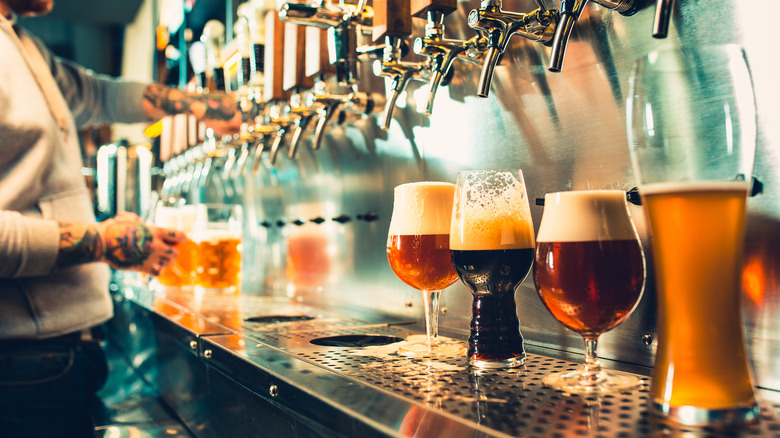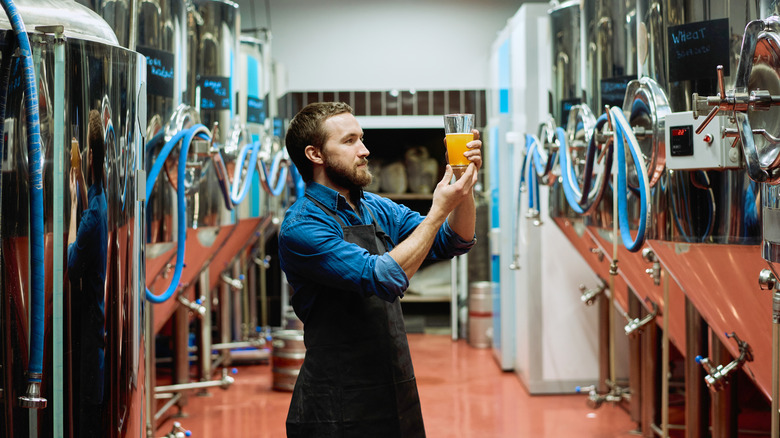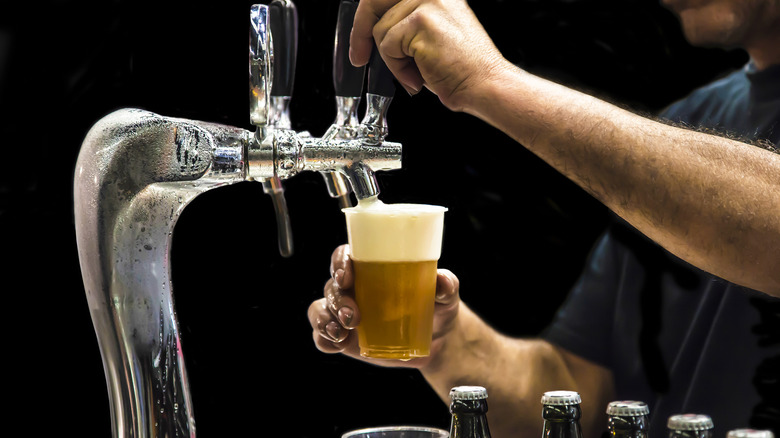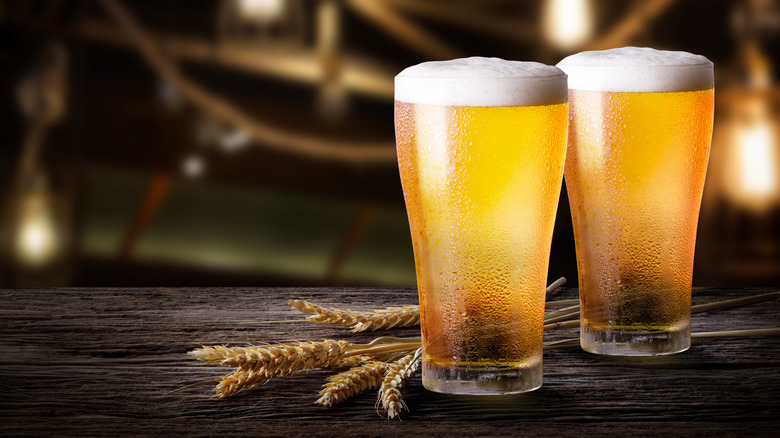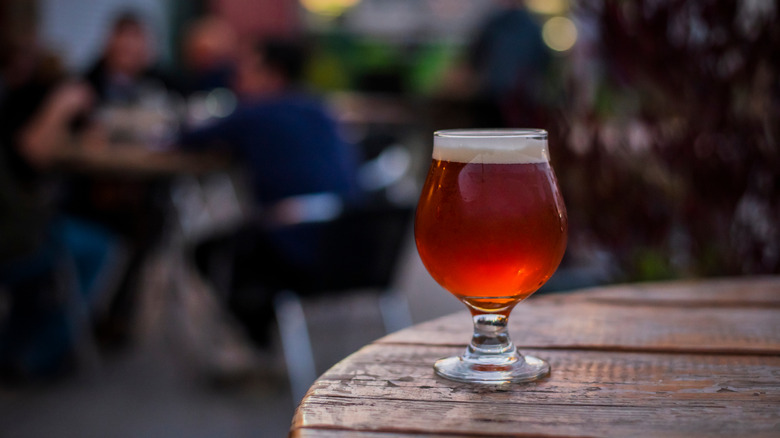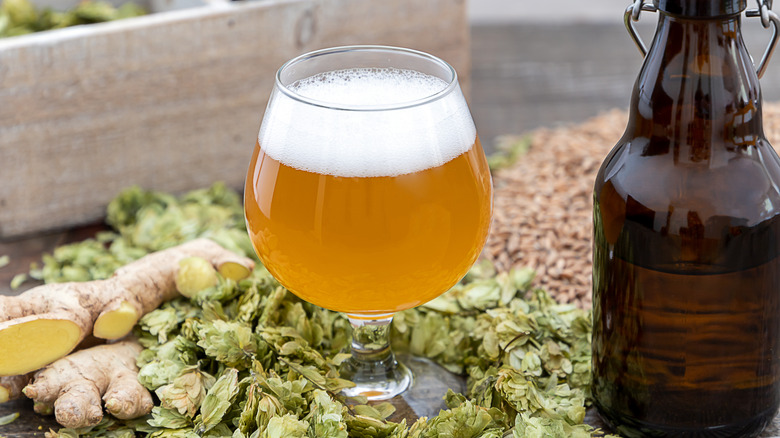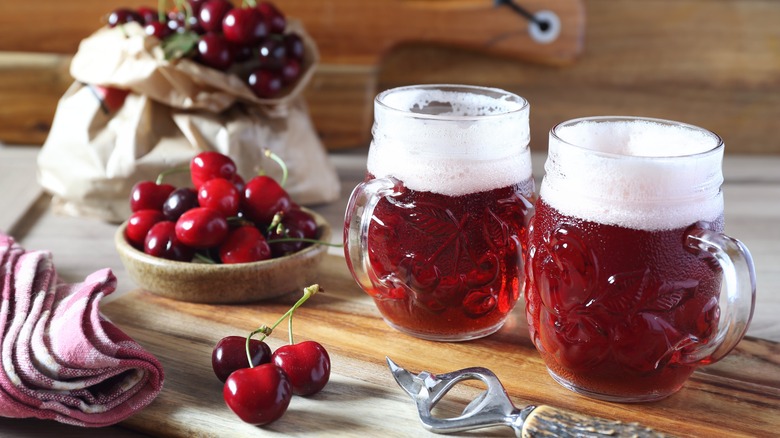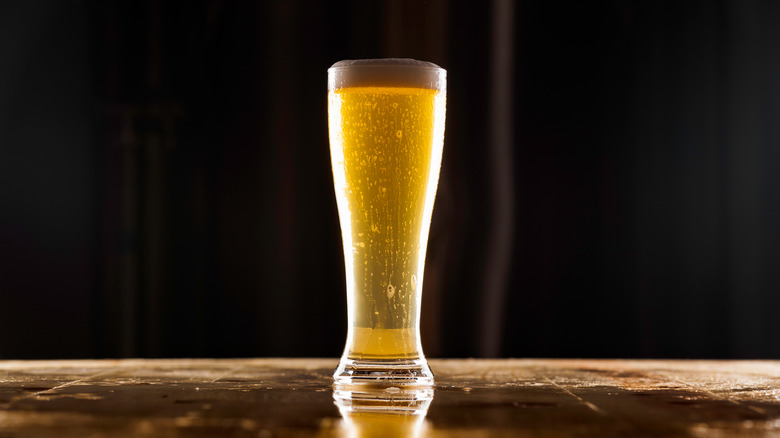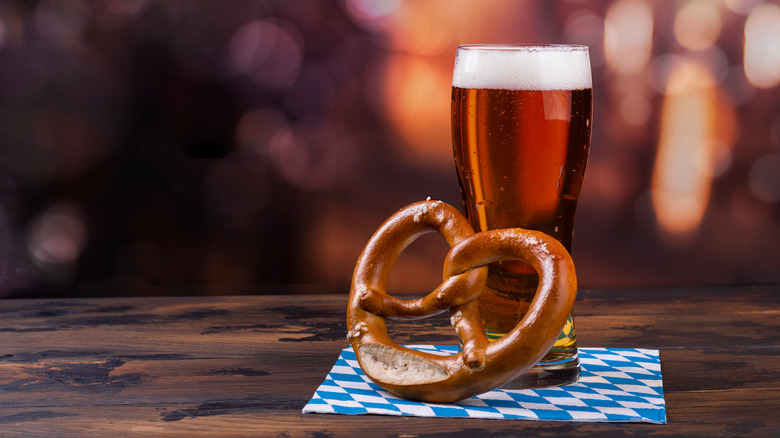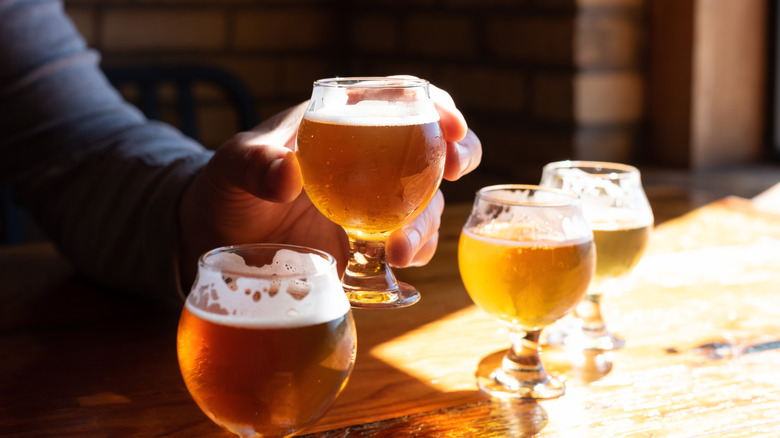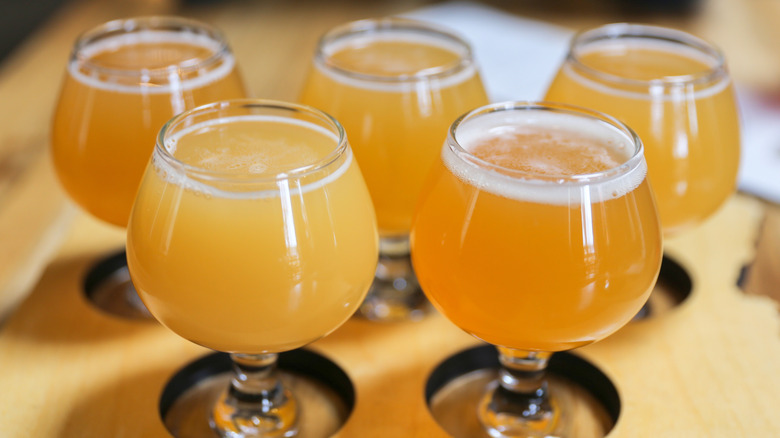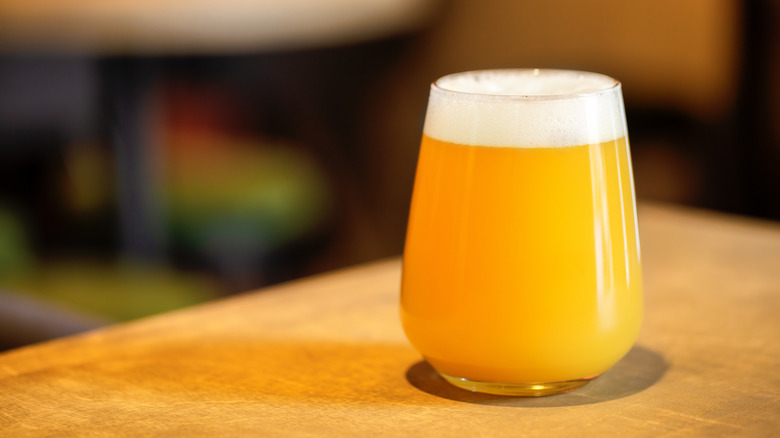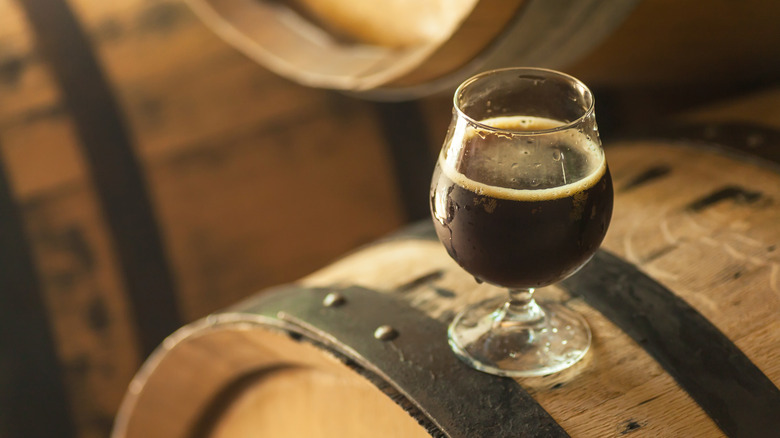The Most Popular Beers You Can Find At A Brewery, Explained
The craft beer industry in the U.S. continues to steadily rise. Just take a look at the numbers. According to the Brewers Association, there were 3,219 brewpubs in 2020 (before the pandemic's effects slowed things down across the economy) — up 1.5% since the count in 2019 and triple the number from 2010 (1,057). In the case of taprooms, the numbers are even more dramatic, with 3,471 in 2020, compared to 3,159 in 2019, an increase of nearly 10% year-over-year.
Indeed, small breweries continue to pop up across the U.S. and a visit to one is a perfect day- or nighttime outing with friends, family, or a significant other. However, if you've yet to make it to a brewery, or are unfamiliar with the wide varieties of craft beer altogether, a brewpub or taproom menu can be intimidating. The names of some beer types and their descriptions can almost seem like they're in a different language — and in some cases, they are.
Despite any initial awkwardness, though, there is a beer out there for everyone. The truth is, you won't know what beers you like until you give them an open-minded sip. To help give you a head start, here's our guide to the most popular beers you can find at a brewery.
Ale vs. Lager
All beers can be broken down into two categories: ales and lagers. The fundamental difference between the two is how they are fermented and with which types of yeast, according to Thrillist. Although the difference may seem minor, the type of yeast used for fermentation does make a substantial difference in flavor. Plus, lagers are usually fermented at cold temperatures and ales at warmer ones.
Per Thrillist, ale yeasts produce more esters and phenols during fermentation, which remove hoppy or malty flavoring. This is what allows ales to carry more fruity or botanical flavors and more mellow drinkability. Of course, there are many different kinds of ales and ale yeasts used for fermentation, but the general characteristic of an ale is its lack of the crisp and sharp tastes of their lager yeast counterparts.
While the vast majority of beers are either one or the other, there are styles of beers that are a hybrid of the two. For example, Kölschs are fermented using ale yeast but are stored at lager (i.e., cooler) temperatures (via Craft Beer & Brewing). Such hybrids, when navigated by an experienced brewer, can make for a brew encapsulating the best of both worlds.
Blond Ale
Blond ale. Golden ale. They're the same: clear, crisp, dry, and very light. Blond ales sip very easily and are perfect when in need of some refreshment. They carry very minimal flavor notes, normally consisting of slight fruit, malt, and or grain, according to Kegerator.com.
Blond ales originated in the late 1800s, back when it was brewed as a lighter version of a pale ale, but have stood the test of time and live on in the taprooms of today. Blond ales are quite common on brewery tap lists and are an excellent access point to craft beer for those who typically don't like the more hoppy, at times harsher tasting beers that have shooed them away in the past.
Blond ales feature a medium-light to medium body, with an ABV content between 3.5% and 5.0%. As CraftBeer.com describes it, a blond ale is approachable thanks to its simplicity; further, because blond or golden ales are so light (and smooth), you can pair them with a wide variety of foods, from spaghetti and meatballs to sugar cookies.
Wheat Ale
It is widely known that the typical commercial beer is produced from barley grain, so the idea of a wheat ale can confuse those new to craft beer. Wheat ales are any beer made from at least 50% malted or unmalted wheat, according to Renegade Brewing. Brewing using wheat was a completely new phenomenon in the U.S. during the first microbrewery boom in the 1980s. Brewers in Europe, however, have been brewing beer from wheat for thousands of years. In fact, records of wheat ales date back to 800 BCE in the Bavarian region, or modern-day Germany (via World History Encyclopedia).
Wheat ales are typically golden or pale yellow in color and appear hazy due to the amount of protein content from the wheat. The aroma of wheat ales does vary quite a bit. The pure, Bavarian-style wheat ales, known as Hefeweizens, carry a banana and clove aroma while many American-style wheat ales are more citrusy.
Other regional wheat ales include Witbiers from Belgium and Berliner Weisse from Poland. Malt is obviously a factor in both the taste and smell, but the flavors of wheat ales are normally very mild because of their low and sometimes complete lack of hops. Wheat ales are very drinkable with a dry finish, and have an ABV range usually between 3% and 5%.
Red Ale
Red ales are another beer with a lower alcohol content and good balance of flavor. According to CraftBeer.com, red ales are made using a balance between moderate amounts of kilned malts and roasted barley, which is what gives this ale its color and namesake. However, red ales can also be recognized as amber ales. Red ales are usually hopped, but only a moderate and completely approachable amount.
In fact, this is actually a good beer to introduce yourself or a friend to hops. The beer can actually be brewed as an ale or as a lager, but the name does not normally reflect the difference. Red ales carry a sweet, almost caramel like malty flavor and have a medium body, making it a great, robust beer suitable year-round.
This beer comes from Ireland, but American breweries have stamped their own geography into the red ale. Red ales are quite common at craft breweries, and each one can provide different flavors. Red ales typically fall between 4% and 5% on the ABV scale.
Saison
Saison (or "season" in French) is also known as a farmhouse ale, a reference to its origin: the farmhouses of Wallonia, Belgium, per Hop Culture. This ale was originally made for farmers working in the summer, and its chief characteristics reflect such necessity. Saisons have a light body, low alcohol content, high carbonation, and a crisp, dry finish. The reason this ale has become so popular in craft breweries is because the style is wide open to interpretation.
American brewers have expanded saisons with higher alcohol content and added hops, all while preserving the fundamental lightness and dryness. Whichever saison you try, you will know you are sipping on a unique, personal rendition. Saisons are approachable and straightforward, any of these added flavor notes or brewing techniques are easily recognizable. If you ever come across a brewery menu with a saison, try it. It's guaranteed to be one-of-a-kind. The ABV range of saisons can lie between 4.5% and 7.0%, according to CraftBeer.com.
Sour Ale
Sours are one of the most popular styles of beer for non-beer drinkers. According to WebstaurantStore, brewing a sour takes a lot of skill and a lengthy resting period, but the reward is a unique, drinkable beer that will always take up a spot on a beer flight.
Sours acquire their distinct flavor from a brewing process that actually uses wild bacteria and yeast. While other beers are fermented with controlled strains of yeast, sours are naturally fermented by a more organic development of the yeast. While the inclusion of wild bacteria may seem concerning, this is a common practice in food production. The same bacteria used to brew sour ales is the same kind of bacteria found in greek yogurt and other dairy products. This bacteria is what gives sours its tart flavor profile and mouthfeel, two components of the ale that are commonly paired wonderfully with fruit and sweet flavoring.
There are many different kinds of sour ales, the most popular and general of which is the American wild ale, referring to any sour made in the U.S. There are also Göses from Goslar, Germany; Lambics from Belgium; and Guezes, a type of lambic that's often flavored with cherries. Given this room for experimentation when it comes to sour ales, their alcohol content naturally varies. The ABV of sours can range anywhere from 2.0% to 9.0%.
Pilsner
Pilsners are a pale lager originally from Plzen, Czech Republic, and according to VinePair, their creation is thanks to a man named Josef Groll, who, back in the 19th century, added Saaz hops to some spoiled beer, saving the brew and inventing the pilsner (from a lager) in the process.
Conditioned at colder temperatures, pilsners can range in color from extremely pale to amber-colored, depending on the types of grain used for brewing, per Home Brew Advice. Brewed with unroasted barley, pilsners get their clear and crisp taste from what is known as soft water — i.e., water without any dissolved minerals that works very well with yeast. As said, pilsners are hopped with Saaz hops, which is mostly only used as an aromatic (remember the spoiled beer) but does provide a delicate bite for a sharp finish.
Pilsners are actually the most widely manufactured beer in the world, and American breweries are no exception. The original Czech-style pilsners are the most popular, but pilsner styles can be replicated from all over. German-style pilsners are very similar to the Czech-style, and American-style pilsners are the kind that incorporate corn or rice (for color). No matter the style, though, pilsners are a light, malty, refreshing beer usually containing an ABV between 4.0% and 5.0%.
Oktoberfest Lager
Every September, liquor stores get shipment after shipment of Oktoberfests from all over. If your local brewery knows it's good for them, they'll release their own Oktoberfest for the annual celebration. The fall season can't begin without it, and this iconic style of beer is a gift from the motherland of beer.
This German beer, also known as märzen (March), can be traced back to the inaugural Oktoberfest celebration in Munich, Germany, in 1810, when Prince Ludwig of Bavaria decided to celebrate his marriage with commoners rather than privately with his fellow royals, per Chowhound. Its name, named after a month seven months before October, is due to the weather and the fact that beer had to be brewed before it became too warm, hence it was done in the spring.
Oktoberfests range in color from burnt golds to darker ambers and reds. They carry flavors of sweetness and very mellow, drawn out malt. Oktoberfests utilize Saaz, Tettnanger, and Hallertau hops, but malt remains the dominant player. The ABV of Oktoberfests normally falls between 5.0% and 6.0%.
Oktoberfests are a fun, delicious way to bring in the fall season and the perfect avenue toward visiting a your local brewery or beer garden and enjoying the crisp air, changing foliage, and a medium-bodied, tasty beer.
American Pale Ale
American Pale Ale (APA) is a fundamental player in the rise of brewery popularity. Though pale ales date back hundreds of years to England, America made it its own in the mid-1970s, according to Kegerator.com. The rebirth of pale ales in the U.S. brought with it a revival of dry hopping as well, with the first well-known, modern APA coming out of California (Anchor Brewing) in 1975. As it turns out, cascade hops became the American twist on an English recipe.
The main difference between English pale ales and American pale ales is their respective, native ingredients. While English hops are more botanical and earthy, the hops used in APAs carry a more citrus and pine profile. Per Craft Beer & Brewing, this makes English pale ales more nutty with a "caramel or toffee-like depth," and maybe less approachable to newcomers than the more crisp, neutral palatability as American pale ales.
American pale ales are largely up to interpretation. Aroma ranges from moderate to strong, and some APAs are crystal clear in color while others a bit hazy, depending on the amount of dry hops. Fruity flavor notes can be present in APAs but the usual, widespread characteristics are that they are malty, smooth, highly carbonated, slightly hopped, and medium bodied. American pale ales are really the first step into hop-forward brews, and this style is a very inviting entryway. The ABV of American pale ales can range from 4.0% to 6.0%.
India Pale Ale
The India Pale Ale (IPA) is the flagship craft beer. There are several types of IPAs, all of which have their own variations and plenty of room for experimentation. They vary as far as amounts of hops, yeast, and sweetness.
All IPAs are hopped, according to Bon Appétit. They can be dry-hopped, which means the hops are steeped during fermentation, instead of during boiling. Single-hopped IPAs are brewed using one single variety of hops. Hops can be added during the boil, at the finish and in fermentation. Fresh-hopped IPAs are the most rare. An IPA can only be considered fresh-hopped if it uses hops picked at the peak of harvesting season in August and September, and are added to the boil within 24 hours of their picking.
A session IPA simply means it has a lower alcohol content. No matter the style of IPA, the word "session" can come before it. Session IPAs normally fall below 5.0% ABV, so they are lighter options with a thinner body.
The main styles of IPAs include the most popular and straightforward New England IPA, the very fruity and sweet West Coast IPA, and the softer and more mellow Oat IPA. Milkshake IPAs are creamy, sweet and hazy from their milk sugar, so do not mistake their content for actual dairy. Belgian IPAs are toasty and rich, and Brett IPAs get their name from the yeast strain brettanomyces. Just like how there's a beer out there for everyone, there's an IPA out there for everyone, too.
Double India Pale Ale
Double or Imperial IPAs are simply just a step up from regular IPAs. Double IPAs have a higher alcohol content, about double the amount of hops, and are more full-bodied, according to Beer Advocate. Like regular IPAs, the balance, flavor, and overall style of double IPAs are basically up to the individual brewer. There is a common misconception that double IPA means the beer is double-hopped. The term "double-hopped" is not really a thing, technically. Hops can be added at any stage of the brewing process, but double-hopped is mostly used to simply entice those looking for a more hoppy beer. Double IPAs can even have triple the hops (via The Kitchn).
Some double IPAs aim to achieve a balance between enhanced hoppiness and higher malt profile, while other double IPAs are intentionally unbalanced and carry an embellished amount of hops to satisfy some people's acquired taste for bitterness. Most double IPAs aim to fall between 7.0% and 9.0% ABV. Any double IPA with an ABV higher than 9.0% runs the risk of being less drinkable to any craft beer newcomers. Once that taste for bitterness is acquired however, double IPAs are an intense, full-bodied beer that is a good finish line to your brewery visit, especially if available in lower volume glassware.
Porter vs. Stout
As far as flavors go, there are different variations of both porters and stouts. Generally, porters are often brewed with chocolate malts and roasted barley. Stouts also have a roasted flavor, but that flavor comes from notes of coffee and are more bittersweet. In appearance, porters and stouts are slightly different. Porters are usually a dark brown and stouts completely black. Per The Kitchn, while porters use malted barley, stouts tend to go the unmalted roasted barley route (hence, the "coffee" flavor).
Types of porters include robust porters, made with roasted malt, smelling and tasting of both chocolate and coffee. Brown porters are the original style of porter and are also known as London Porters, according to Craft Beering. Baltic porters are actually lagers, not ales. They carry some of the same characteristics of brown porters and come from the Baltic states with an influence from Russian stouts.
Variations of stouts include dry stouts, which are very similar to robust porters in their content of roasted barley and malt. These are moderately sharp with some hops, which makes them completely black with no clarity. Oatmeal stouts are prominent in roasted grains and have a thick, creamy head atop their dark body (via CraftBeer.com). Imperial stouts are imperial for the same reason as Imperial IPAs, as their ABV is at least 9.0%. These stouts are dominated by roasted barley and range from a dark amber to jet black.
